
Paola Castro is a senior majoring in Computer Science at Florida International University. Having grown up in Puerto Rico, and later coming to pursue higher education in south Florida, she was able to meet other people of various cultural backgrounds and learn more about the vibrant communities of south Florida. As someone who is interested in the history, art, writing, and politics of the Caribbean and south Florida, she is eager to explore Miami in this course.
Downtown as Text
Even in the years prior to its official establishment, Miami was the “melting pot” we celebrate today – and understandably so. It is not a stretch to say that south Florida is a natural extension of the Caribbean, sharing many of its historical trends and its sheer variety of inhabitants. Much like the islands of the Caribbean, Miami was inhabited by a multitude of people since its beginning, offering a home to Tequesta natives, Bahamians, Africans, and European settlers.

People of color built Miami from the ground up, in more ways than one. Their various contributions are what allowed Miami to prosper. Without the Tequesta natives’ techniques for taking care of the land, Miami’s soil wouldn’t be fertile enough to start growing crops for profit. Without slaves to tend to the crops within the farmland, the railroad would not have been brought down to south Florida for the purpose of shipping food up north (a decision which later allowed the city to grow and get officially established).

Unfortunately, these contributions later spelled the marginalized communities’ doom, in one way or another. The fertile land Tequesta natives cultivated was coveted by wealthier European settlers and later taken by the settlers, driving the Tequesta out of their own communities. Barracks created by enslaved Africans and Bahamians were later used as forts to fight native people in the Seminole Wars. Even the railroad brought down to south Florida by Henry Flagler later led to segregated communities, one of which being modern day Overtown.

People living in Miami nowadays, ignorant of the town’s history, may see these formerly segregated neighborhoods populated by people of color as a failure. They may assume that these communities are in dire straits through some fault of their own, some character flaw or just bad work ethic. The truth of history tells another story. Miami – much like other big cities around the world – has a history of profiting off of marginalized people’s labor, even using it against them at times. It’s difficult to pull yourself up by your bootstraps when your bootstraps are constantly stolen from you.
Make no mistake, Miami was built by the marginalized.
Overtown as Text

Communities form in many different ways – sometimes through shared hardship, sometimes through shared goals or histories. For the neighborhood of Overtown, it is all three. Miami’s history of segregation and its subsequent hardships may have created Overtown, but what made it grow into a vibrant community was its inhabitants’ shared goal of prosperity and progress.
When discussing Overtown, it is very necessary to mention its grim origin story of exclusion (shown even in its original name, Colored Town). After all, history is doomed to repeat itself if we don’t learn from past mistakes and prejudices. But I have a problem when that dark history is the only thing mentioned. After all, the citizens of Overtown created a wonderful community for themselves to live in – full of business and music! Nowhere was this more apparent than the overlapping business lined streets and the street that housed the Lyric Theater and what was then called ‘Little Broadway’. From soul food to music to small businesses, the people of Overtown turned a forced living situation into a place they would be proud to call home.

Not only that, but the community was not all about entertainment and success, it was also very collective. Overtown began its first black police squad, in order to reduce the unnecessary brutality born of racism often inflicted on people of color within their own communities. Not only that but two historic churches, which still stand today, provided essential services to those who needed help – a practice they are still committed to even today, as they give free showers to the homeless in one of the church’s mobile vans.
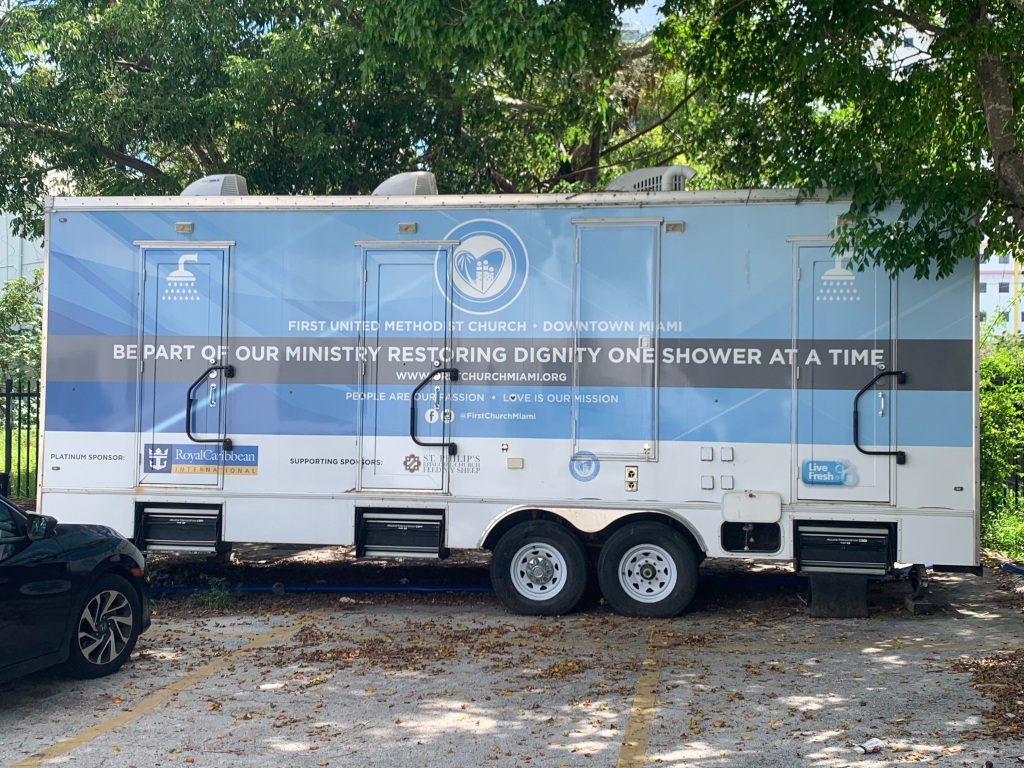
Overall, while it’s important to grieve the circumstances that brought the community together, it is also worth celebrating the immense effort the townspeople gave in making their community a vibrant, safe, and supportive home for all who lived in it. When visiting historic neighborhoods, it’s important to remember that along with the hardships endured, there was also joy to be had.
Vizcaya as Text
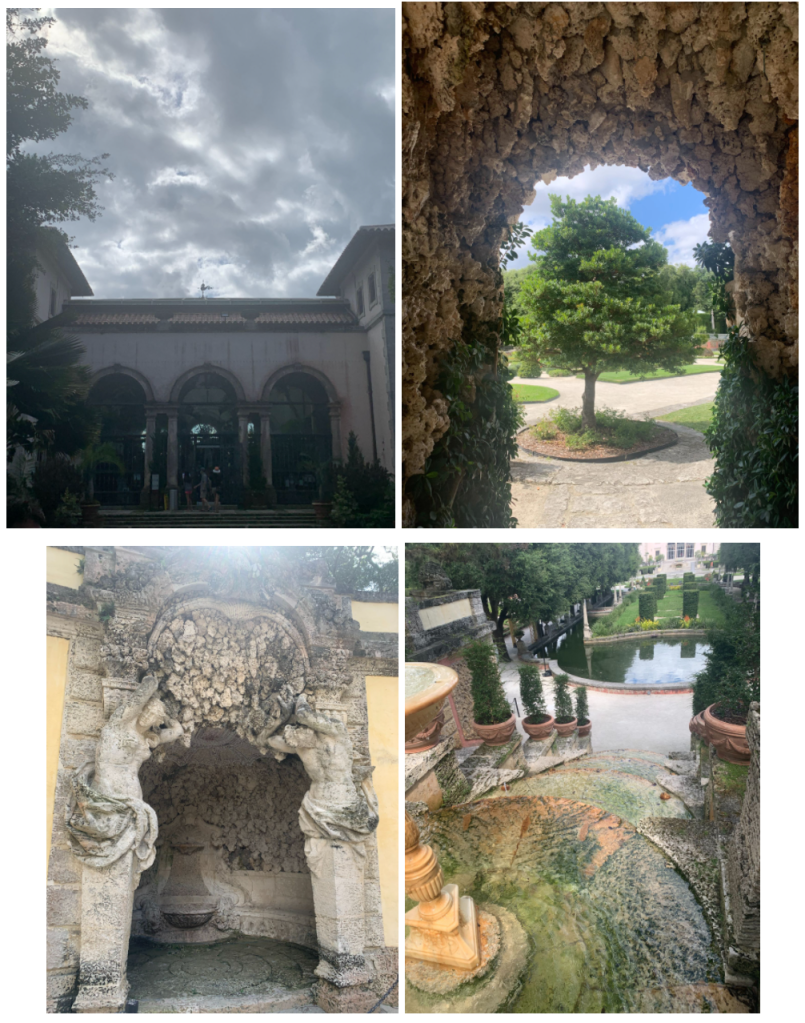
Throughout the tour of the Vizcaya museum and its gardens, all I could notice is how custom-made for its original owner everything was. Every single aspect of the estate was made with Deering’s peace and pleasure in mind, down to the last detail. Nowhere can this be seen more clearly than the gardens, where the landscaping creates less of a garden and more of an extension of the house with rest areas, plentiful shade, and entertainment in the form of hedge mazes. Having been built from scratch in a previously undeveloped forest area, even the nature outside of the garden grounds was altered to suit his needs – such as the moat surrounding the estate and the stone taken from it to use in other areas of the house.
It was refreshing to see Deering’s realized vision of taking what was naturally beautiful about the area before it was developed and making it not only more beautiful, but also livable and comfortable for him and his guests. Nowadays, many famous architects are paid to create spaces in the city of Miami, but as they have never had to live in the city for a long time, they end up creating beautiful but impractical public spaces. One example of this is the courtyard we saw on our first Miami in Miami class that was built to be a public space for museum goers but, due to offering no protection from the scorching sun, is usually vacant. And that is just one example of many.
In contrast to that thoughtless construction, Vizcaya’s outdoor areas are positively heavenly. As soon as you walk out, the serene sound of running water calms you down, the sheer amount of lover’s benches provide many opportunities for resting or lounging, and small, water cooled grottos provide ample shade and respite from the harsh sun. It truly was made for the comfort of all who visit, since even in such a humongous garden, you’re never more than 20 feet away from shade and rest areas.
After visiting Vizcaya, I truly hope the city of Miami will take some notes on how to make public areas comfortable as well as beautiful for all who visit, so that more people are encouraged to spend the day outside. Making public areas comfortable does not always have to cost a fortune, but it does require vision – something Deering and his crew definitely possessed.
SoBe as Text

While walking down South Beach, I was amazed by the way that I felt Miami’s culture – at least in the way Miami is represented in media – was showcased in this one area. Not only do we have the wonderful beach and pier, but also the local shops, famous movie locations, and interesting art installations. The more I walked around and learned about it though, the more eclectic and strange it all seemed. There was so much going on all at once, it all seemed too over the top – weird at times even. Although, that is probably exactly why it has become a huge Miami cultural staple.
Unique art and culture is born of things that are weird, unnecessary, and even sometimes impractical. After all, when art deco architecture was first created, it did not come from people who wanted to stick to what was practical or prevalent at the moment. It was brought on by a desire to look to the future and reimagine what was possible, at the cost of looking strange and being more difficult to construct. What was strange then moved on to become a huge movement in the art world, and one of the biggest architectural feats in Miami – something it’s known for across the country. And this pattern continues throughout South Beach and all its famous spots.
From the largest art deco neighborhood in the country to the Betsy Orb all the way to a Jewish Museum with an alley inside of it and a beach made of imported sand, none of South Beach’s interesting locations could ever be called conventional. And that is precisely what makes it one of the most fascinating places in Miami. Not in spite of its strangeness, but because of it.
Deering Estate as Text
Unfortunately, due to a serious knee injury I sustained during the semester, I was not able to attend this class as I could not physically do the hike required.
UNTITLED as Text

As someone who grew up in the same city as the largest museum in the Caribbean, I’ve always had an innate appreciation for art, and felt at home in an art gallery. However, after visiting UNTITLED and getting to listen to famous artists from all over the world explain their art, I gained an entirely new perspective on the ways art can tell a story. Every artist I had the pleasure of speaking to had a distinct way of displaying the message they hoped to capture in their art.
Some let the medium tell the story, mixing the natural with the artificial or using mediums in new and interesting ways.
Some simply chose to shine the spotlight on something taken for granted or actively despised and decided to celebrate it in their piece.
Others built upon their predecessors, making allusions in their pieces to famous artists that inspired them or incorporating aspects of their culture that hold meaning to them.
Still others did not even seem to want to convey meaning, but rather give the public a new experience, surreal and memorable.
With all the ways these artists creatively chose to showcase meaning in their piece, I was overwhelmed and inspired – especially considering the fact that I resonated with many of the pieces as they came from artists that have had similar experiences to me as a latin woman struggling with my identity, both as a woman and with my culture. Overall, I really enjoyed the installations and learned a lot about the various forms art can take to convey their intentions.
Coral Gables as Text

The city of Coral Gables has been recognized as an exceptionally luxurious community in Miami for a long time, thanks to George Merrick and his unique vision for the city. Merrick was not a perfect man by any means, but one thing he undoubtedly got right was the way that his seemingly impossible dream could be turned into a self fulfilling prophecy. He did this by understanding one simple principle: that the illusion of wealth and luxury brings about the real thing.
Merrick understood the true power of opulence on the decisions of the wealthy, and used it to his advantage. By housing potential land owners in the elegant Biltmore hotel and then bringing them over to the breathtakingly large Colonnade Building to finalize their sale, he surrounded them with the aesthetics of wealth and grandeur. Even skeptical buyers were swayed by their lush surroundings, and bought into Merrick’s dream of a city. After a while, the city grew into a place where The Biltmore and the Colonnade did not look out of place, as wealthy landowners invested into the area now that they were its residents. Merrick’s false paradise inevitably became a real one.
In a lot of ways, the way that Coral Gables grew into the idea of what it could be reminds me of all the high-class areas in Miami today. If you think about it, the city of Miami is not very old and thus does not have a long history or traditions that give these areas their value. Miami, as a fairly new city, relies on its aesthetics of wealth and prosperity to draw people in – its fine art, its paradise-like weather, its fanciful hotels and resorts. Because of these glamorous surroundings, it creates a culture and reputation of affluence and becomes a self fulfilling prophecy itself. If enough people think of an area as rich and glamorous, then it will eventually become true.
River of Grass As Text
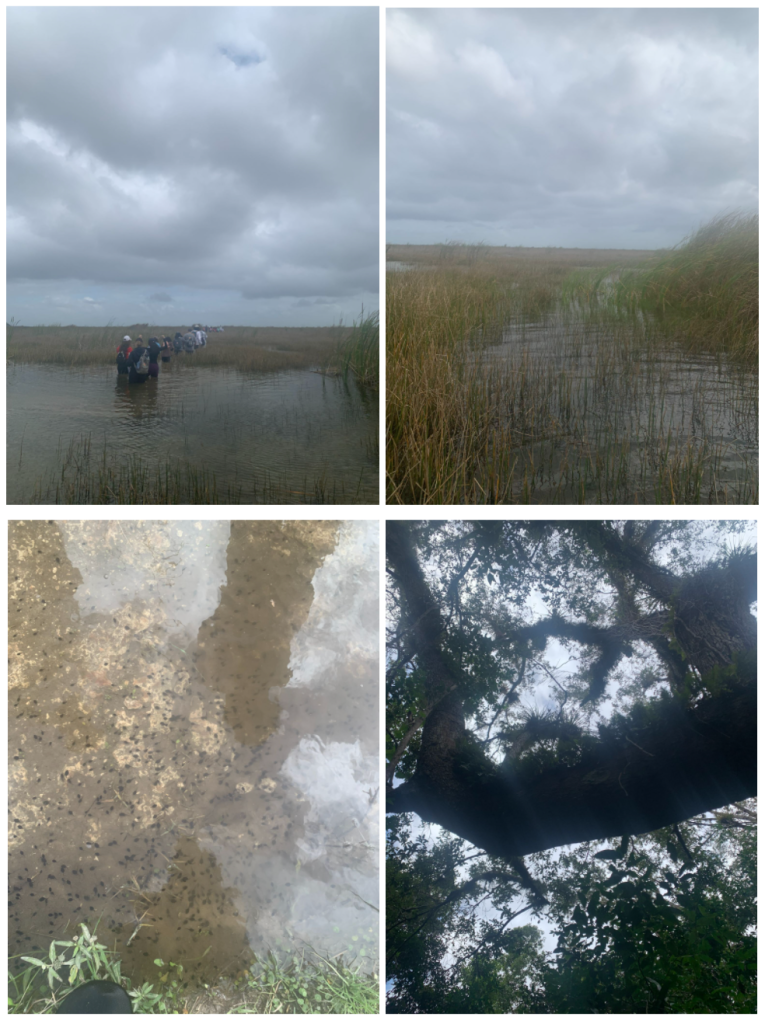
When you live in south Florida in the modern day, it is very easy to forget its origins – its natural landscape that has been reconstructed and molded to suit our needs over time to the point of being unrecognizable from what its founders witnessed at visiting it. Nowadays, it’s easy to forget that Miami is built on swamp land with its huge skyscrapers and constant change due to construction.
Perhaps that is why trekking through the Everglades, separate from all of the modern day luxuries, felt like something akin to the feeling of meeting someone for the first time. In the Everglades I saw south Florida’s true face and shook its hand as I trudged through the muddy water in fields that stretched as far as the eye could see. I met its residents as well – in the puddles where the tadpoles swam in swarms, in the shallow water in the field where dragonflies whizzed past – everywhere I looked I caught glimpses of its inhabitants.
While making my way through this miles long hike, I experienced a deep peace that always comes from being surrounded by nature. In a time when our attention is always being sought by ads and split between tasks in an attempt to multitask and be more productive, the silence and stillness of the fields and forest was refreshing and freed the mind up to wander. This place wasn’t asking anything of us, had no agenda at play, and so it became so much easier to be present and just experience that moment fully.
Wynwood As Text
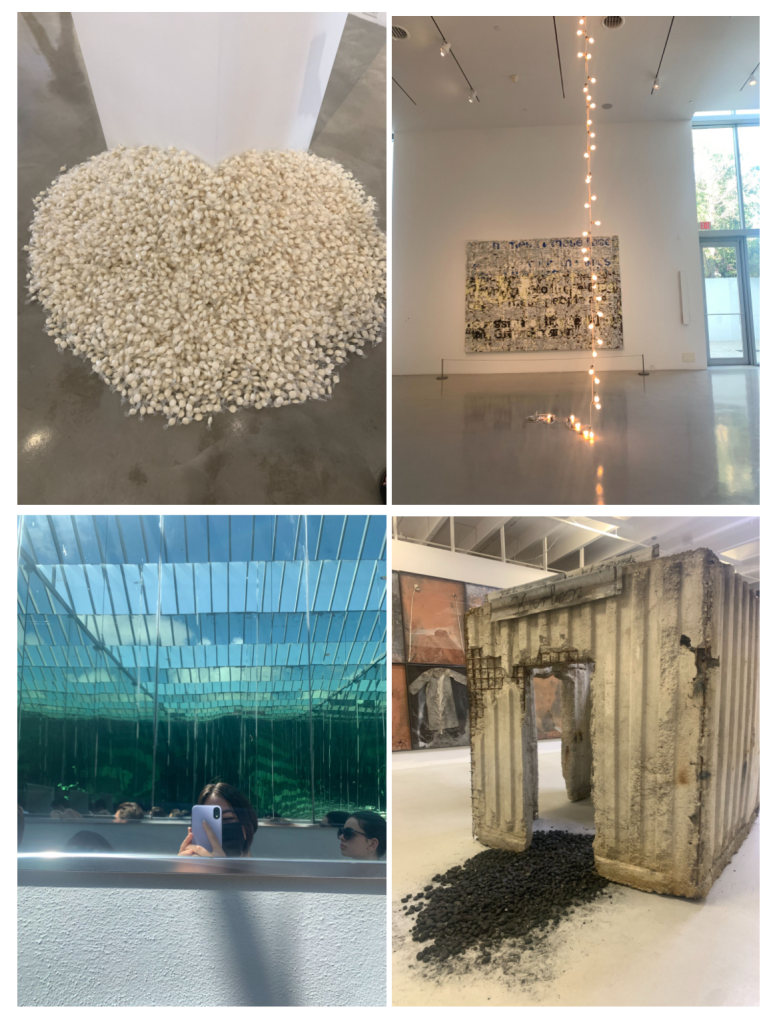
In visiting Wynwood and its resident galleries, art of every kind was seen and experienced. Whether it be murals on the side of buildings, statues, paintings, or just about everything else you can think of, it’s all on display in one part or another of the area. However, the main theme I surmised from all the art seen on my visit was that of perspective – both the stepping into it and the changing of it.
Wynwood itself was just another district full of warehouses of varying purposes, before galleries began to open and change people’s perspective on the then vacant neighborhood. Instead of seeing it as bland and full of empty space, people began to see it as an excellent, spacious canvas for art of all kinds. The modern art that it housed also mainly dealt with perspective, by working to change people’s experience of things they thought they knew all about.
Many pieces in these galleries glorified the mundane, with piles of candy and a string of lights being regarded as fine art rather than everyday items. Other pieces sought to change onlookers’ perspectives of art as a whole, using different materials and techniques than what was traditionally seen as ‘worthy art’ at the time. Still others challenged the status quo by incorporating technology into their work, constantly pushing for more immersive experiences than a canvas and some paint can allow. And some artwork was meant to place you in another’s shoes and make you experience the full emotion of an event or time – such was the case with the pieces inspired by the tragedy of the Holocaust.
All in all, the art makes you ask yourself important questions about the true scope of what art can be as well as what makes something valuable, which I imagine is what the artists were hoping to achieve after all.
Key Biscayne As Text
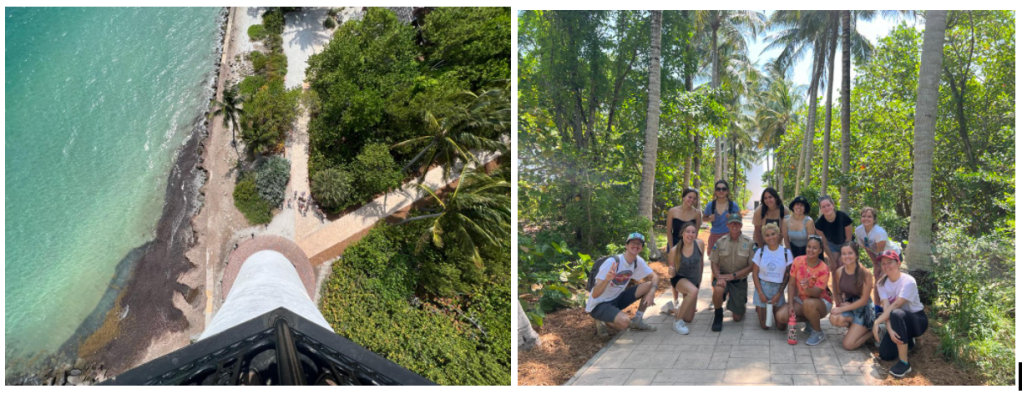
In visiting key Biscayne and Bill Baggs State Park, the overarching theme of the area seemed to be preservation above all. Despite all that happened around the park and its resident lighthouse, the area managed to preserve the glorious nature areas, building infrastructure, as well as its natural species of flora and fauna. This difficult yet well worthwhile feat of preservation was carried out not only at the state level, but also at the individual level. After all, the park is named after influential Miami News editor Bill Baggs, who played a large part in protecting the key from further development by persuading the public on the issue. One must not overlook the efforts taken after succeeding in making it a recognized state park, since its maintenance and care is all thanks to the work of state park rangers living on the key itself – who work tirelessly to keep the park as it is.
Beside the more common meaning of preservation, though, the key also lent its hand in the preservation of human freedoms – serving as part of the Saltwater Underground Railroad that would allow slaves to go to the Bahamas, where they could live as freemen. Over the many years it was part of this route, it is unclear how many people this route helped bring freedom to due to lack of historical records on these occurrences. However, a conservative guess would be somewhere in the range of 3,000 to 6,000 people reaching the Bahamas by the mid 1830’s.
Preservation, in hindsight, is not always at the expense of progress – as the general media likes to claim so often. It may not be home to the next restaurant chain but if anything, it can be the gift that keeps on giving. From the rangers that get to call the key their home, to the visitors that come to bask in its nature and beautiful beaches, and even to the people bound to servitude that managed to escape their miseries through the Saltwater Railroad, Key Biscayne provided endless value and joy. May it stay the same for another 100 years.